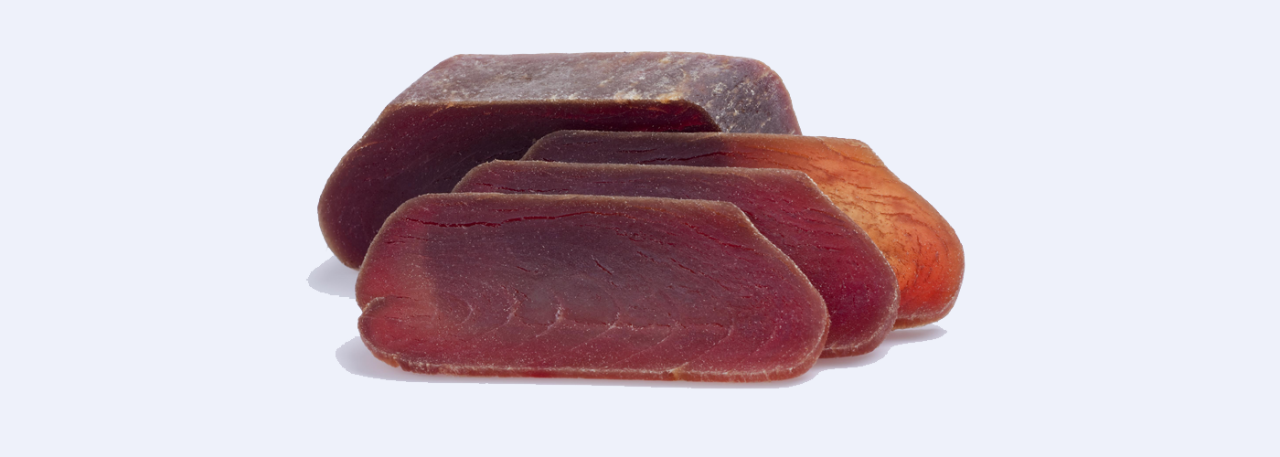.png.transform/rendition-xs/image_image%20(1).png)
Mojama de Isla Cristina PGI & Mojama de Barbate PGI
Both ‘Mojama de Isla Cristina’ and 'Mojama de Barbate' are made from wild tuna loin of the following species: Thunnus albacares, commercially known as yellowfin tuna, light tuna or rabil, and Thunnus thynnus, commercially known as bluefin tuna, with a live weight of more than 200 kg. Both the upper and lower loins are used, cured by being seasoned and dried in the air or in tunnels designed for that purpose.
Tasting notes
Mojama is dark brown on the outside, while on the inside there are the streaks characteristic of tuna loin, which are much more conspicuous in Categoría Primera than in Categoría Extra. When cut it is varying shades of deep red, darker at the edges.
Its texture is compact, smooth and not very fibrous, and it smells and tastes of lightly salted oily fish.
Other notes
The salt content is between 3 % and 9 %, and relative moisture must be between 40 % and 50 %.
Production / Processing method
The following operations take place in the defined geographical area:
1) The tuna is washed with drinking water through a hose until all the blood and dirt on the skin is removed.
2) Cutting-up (Ronqueo): The tuna starts to be cut up in the handling room and is done manually by specialised personnel using the right blades to achieve a quick, clean cut. This cutting process is known a 'ronqueo'.
The process begins with the head being cut off and the tuna being eviscerated, ensuring careful, correct bleeding. Then the tuna trunk is separated by removing the backbone.
The tuna is cut into four loins: the upper two (red or black) and the lower two (white or belly). The skin, bones and black parts are removed from the steak. The four loins obtained from the upper loins and the four from the lower are, once cleaned, washed and cut into strips. The length of the strips will depend on the length of the tuna loin. They may be no thicker than 5 cm. These loins are separated depending on the fat level so that those furthest away from the spine are the fattiest and classed as Primera and those nearest are the least fatty and classed as Extra.
3) Salting: Once the product adaptation stage is finished, the tuna salting process begins. A trough of sea salt is used to salt the strips of tuna. A salt bed between 2 and 4 cm thick is prepared and the strips are placed on it horizontally, alternating layers of salt and tuna with the same thickness. The strips are fully covered to ensure standard distribution of the salt. The troughs must enable water and other liquids to run off. The duration of this water and fat loss, and absorption of salt process varies, lasting between 18 and 36 hours depending on the size and thickness of the strips, the fat content, the moisture of the product and the salt, and even the atmosphere. Before the strips are removed from the trough, they are inspected by an experienced professional in these processes who checks whether the salting has finalised. The salt used in this process may not be reused.
4) Washing of the loins: the workers wash the loins in two stages, initially dipping each strip in a water container and drying it.
Then the strips are placed into troughs with cold water and left to soak between 7 and 9 hours. The water is changed three to four times in this process. The aim here is to reduce the salt concentration to attain the optimal level.
5) Pressing: The strips of loins may then be pressed by being placed in troughs, alternating the boards and strips until the right height is reached. Weights are then placed on top that leads to the strips of loin losing the water from the washing process. Pressing lasts several hours until the loins are sufficiently dry.
6) Curing: Once pressing is completed, the tuna strips are collected and taken to the drying place to start the final mojama production process. The tuna strips are first placed on a horizontal surface for at least two days and are then hung from a hanging element.
The product is vacuum-packed in transparent plastic bags, duly labelled, in pieces of different weights or sliced in olive or sunflower oil. It may also be packed in glass jars, sliced in olive or sunflower oil. The product must be packed at source in order to maintain the physical, chemical and organoleptic characteristics attained at the end of the process, in particular the salt content and relative moisture.
Geography / Relief and climate
The whole coast of the Gulf of Cádiz, lapped by the Atlantic Ocean, has a long fishing and tuna salting tradition, which dates from the times of the Phoenicians and the Tartessians, who taught the fishing techniques to the early inhabitants of the area.
The sea's influence acts as a climate buffer in the island region. Temperatures are mild in winter and hot in summer. The maximum average in July is 34º C, only occasionally surpassing 38º C. Humidity is the most noticeable climate feature, normally hitting values above 100% in winter. The average annual temperature is 24.3º maximum and 14.2º minimum, with total average rainfall of 462mm.
The climate in Barbate and the rest of La Janda coast also corresponds to a Mediterranean climate, characterised by mild temperatures throughout the year and a marked contrast between winter and summer. The presence of the Atlantic Ocean and the confluence of maritime and continental air masses favour an increase in annual rainfall and the presence of frequent, strong winds.
Regulatory Council
Consejo Regulador de las IGP Mojama de Isla Cristina y Barbate
C/ Glorieta del Agua, 4
Edificio Ajamar Center – 2ª planta, oficina nº 9
41940 Tomares (Sevilla)
Andalucía
Tel: (+34) 954 151 823
secretariogeneral@consejoreguladordelamojama.com
Sources:
When cut it is varying shades of deep red, darker at the edges.


- /content/dam/en/icex-foodswines/images/products/preserves/mojama-de-isla-cristina-pgi---mojama-de-barbate-pgi/Mojama%20de%20Isla%20Cristina%20carr1.png
- /content/dam/en/icex-foodswines/images/products/preserves/mojama-de-isla-cristina-pgi---mojama-de-barbate-pgi/Mojama%20de%20Isla%20Cristina%20carr2.png

Tomares (Andalusia)
